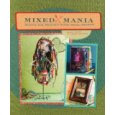 Titian, The Holy Family and a Shepherd
Titian, The Holy Family and a ShepherdI love color and texture! I love abstract modern art! I can "disappear" in a Rothko with ease and great pleasure and return groggily to the "real world." I also love the works of the Italian Renaissance Old Masters. There is something magical about Titian and his use of color in the 16Th century. Until last week, I considered my loves very different and completely disconnected in any obvious way. I tend to have wacky taste in many areas of my life, including art.
However, last Saturday, I was browsing 2nd ed. Booksellers, a used bookstore in the RDU airport, and responded to a book calling my name: Matt's Old Masters. David Sylvester, the late British art critic and curator said of Matthew Collings:
"One of Collings' great strengths is his insistence that
in art things are not either/or but both/and."
Matt's Old Masters focuses on Titian, Rubens, Velazquez, and Hogarth. I found myself fascinated by Collings writings about Titian during a short airline flight, followed by a LONG drive in a tiny rental car to my husband's family home in Montezuma, GA. Collings adeptly makes a connection for me between Italian Renaissance and modern abstract art as follows:
"Titian-style color isn't just bright colour,
which is what people usually think 'colour' means in art.
It's colour worked and organised and constructed,
so it's doing something more than you would get
if a modern designer chose some colours from a colour chart.
It's producing something symphonic and harmonious
out of a lot of differences so
there's a sensation of surprise and delight.
This description would fit a Paul Klee or a Matisse,
or a Pollock or a Rothko--which is right,
because that kind of modern art, small like Klee or vast like Pollock,
harks back to the sparkle and suavity of Venetian painting."
Ahhhh, sparkle and suavity; my kind of art!

No comments:
Post a Comment